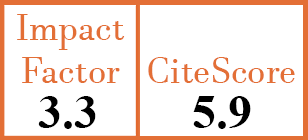Full Papers
Urine soluble triggering receptor expressed on myeloid cells-1 is a novel biomarker for active lupus nephritis: a case-control study
Y. Molad1, M. Egbaria2, A. Tovar3, A. Dortort Lazar4, E. Pokroy Shapira5, S. Oren6, Y. Edel7, V. Kliminski8
- Institute of Rheumatology and Laboratory of Inflammation Research, Felsenstein Medical Research Center, Petah Tikva; Rabin Medical Center, Beilinson Hospital, Petah Tikva; and Sackler Faculty of Medicine, Tel Aviv University, Israel. ymolad@clalit.org.il
- Rabin Medical Center, Beilinson Hospital, Petah Tikva, and Department of Medicine B, Ha’emek Medical Center, Faculty of Medicine, Israel Institute of Technology, Afula, Israel.
- Sackler Faculty of Medicine, Tel Aviv University, and Department of Pathology, Rabin Medical Center, Beilinson Hospital, Petah Tikva, Israel.
- Rabin Medical Center, Beilinson Hospital, Petah Tikva, and Sackler Faculty of Medicine, Tel Aviv University, Israel.
- Rabin Medical Center, Beilinson Hospital, Petah Tikva, and Sackler Faculty of Medicine, Tel Aviv University, Israel.
- Rabin Medical Center, Beilinson Hospital, Petah Tikva, and Sackler Faculty of Medicine, Tel Aviv University, Israel.
- Rabin Medical Center, Beilinson Hospital, Petah Tikva, and Department of Medicine B, Assuta Ashdod University Medical Center, Ben-Gurion University of the Negev, Ashdod, Israel.
- Laboratory of Inflammation Research, Felsenstein Medical Research Center, Rabin Medical Center, Petah Tikva, and Sackler Faculty of Medicine, Tel Aviv University, Israel.
CER15761
2023 Vol.41, N°5
PI 1155, PF 1162
Full Papers
PMID: 36622114 [PubMed]
Received: 10/04/2022
Accepted : 26/09/2022
In Press: 04/01/2023
Published: 03/05/2023
Abstract
OBJECTIVES:
To determine the value of plasma and urine sTREM-1 levels as a biomarker of lupus nephritis (LN) as well as extra-renal systemic lupus erythematosus (SLE).
METHODS:
Consecutive adult patients with SLE attending a tertiary lupus clinic in 2016–2018 were prospectively divided into 3 groups according to SLEDAI-2K and renal-SLEDAI scores: active renal lupus (ARL), active non-renal lupus (ANL), and inactive lupus (IL). Blood and spot urine samples from each group and matched healthy subjects were analysed by means of ELISA for plasma and urine sTREM-1 levels.
RESULTS:
The cohort included 59 patients (mean age 41.5+2.9 years, 85% female) with SLE: 15 ARL, 14 ANL, and 30 IL. The ARL group had higher scores on the SLEDAI-2K and renal-SLEDAI, and higher urine protein/creatinine ratio than the other patient groups (p=0.0001 for all). Plasma sTREM-1 level was highest in the ANL group (p=0.0085). Urine sTREM-1 level was higher in the whole SLE cohort than the healthy controls (p=0.0249), and higher in the ARL group than the others (p=0.0044). Neither plasma nor urine sTREM-1 level was associated with non-renal SLE features. On Spearman correlation analysis, urine sTREM-1 level, but not plasma sTREM-1 level, was correlated positively with renal-SLEDAI score (r=0.34, p=0.018), inversely with serum C3 and C4 levels (r=-0.42, p=0.0027 and r=-0.28, p=0.056, respectively), and positively with proteinuria (UPCR: r=0.32, p=0.0305).
CONCLUSIONS:
Urine sTREM-1 might serve as a potential biomarker of active renal SLE.


